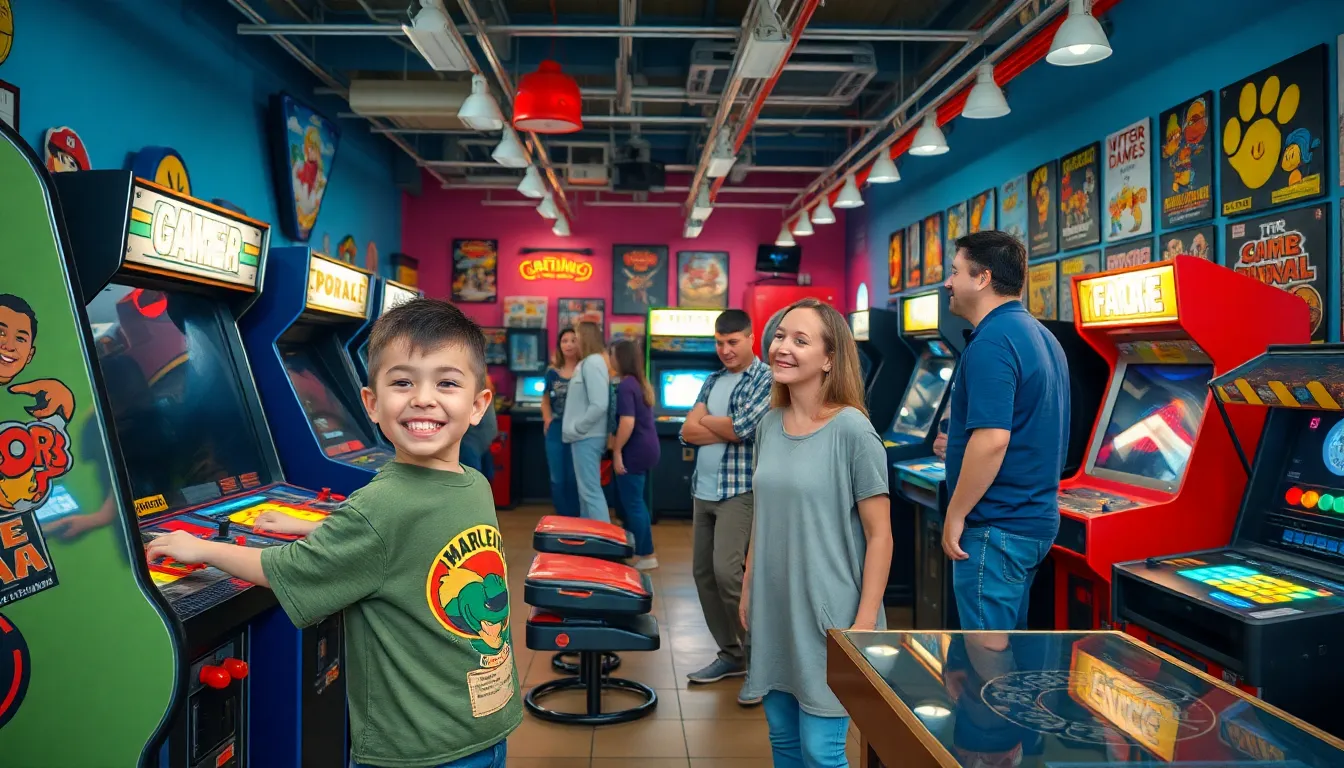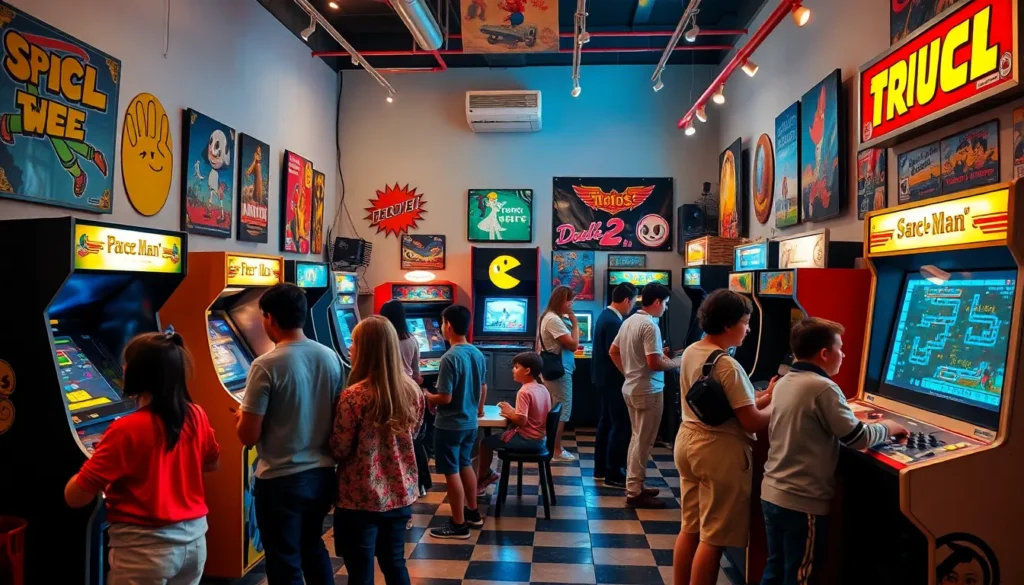Table of Contents
ToggleIn a world where technology evolves at lightning speed, retro gaming museums offer a nostalgic escape into the past. These unique spaces celebrate the rich history of video games, showcasing everything from classic consoles to iconic arcade machines. Visitors can immerse themselves in the golden age of gaming and experience firsthand the evolution of beloved franchises.
Retro gaming museums serve as a bridge between generations, allowing older gamers to relive their childhood memories while introducing younger audiences to the roots of their favorite pastimes. With interactive exhibits and rare collectibles, these museums not only preserve gaming history but also foster a sense of community among enthusiasts. Whether you’re a die-hard fan or a curious newcomer, exploring a retro gaming museum promises an unforgettable journey through the pixels of yesteryear.
Overview of Retro Gaming Museums
Retro gaming museums showcase the history and evolution of video games while offering a nostalgic experience for visitors. These spaces bridge the gap between generations, celebrating the art and culture of gaming.
Definition and Purpose
Retro gaming museums are dedicated spaces that focus on preserving video game history. They host exhibitions featuring classic consoles, arcade machines, and vintage gaming memorabilia. The primary purpose includes educating the public about the origins of gaming, highlighting technological advancements, and fostering a sense of community among gaming enthusiasts. By encouraging interaction through playable exhibits, these museums facilitate a hands-on experience that enriches visitors’ understanding of gaming heritage.
Historical Significance
Retro gaming museums hold significant historical value by documenting the evolution of gaming from the 1970s to the early 2000s. They showcase rare artifacts and pivotal milestones in video game development, including iconic systems and legendary titles. By preserving these elements, these museums contribute to cultural heritage, emphasizing gaming’s role in shaping entertainment and technological innovation. They also serve as a reminder of the digital culture that influenced societal changes, making them pivotal in understanding contemporary gaming trends and the nostalgia they invoke.
Popular Retro Gaming Museums

Numerous retro gaming museums highlight the history and evolution of video games, showcasing artifacts and engaging exhibits that attract enthusiasts and newcomers alike. Here are a few notable examples.
The Video Game History Foundation
The Video Game History Foundation, located in California, focuses on preserving, documenting, and sharing video game history. It houses a vast collection of artifacts, including consoles, games, and developer materials. The foundation actively works to educate the public through research, exhibitions, and community outreach programs. Visitors can explore exhibits that chronicle significant milestones in gaming, emphasizing key developments in technology and design.
The Museum of Play
The Museum of Play in Rochester, New York, features an extensive collection dedicated to the history of play, including video games. Its interactive exhibits invite visitors to engage with classic consoles and arcade games from the ’70s through the ’90s. The museum hosts various events and educational programs, making it a hub for families and retro gaming fans. Highlights include a dedicated video game hall that features rare titles and the evolution of gaming technology, offering insights into how video games have shaped entertainment culture.
The Arcade Museum
The Arcade Museum, located in multiple locations including California and Nevada, celebrates the golden age of arcade gaming. This museum showcases vintage arcade machines, pinball games, and immersive interactive exhibits. Visitors can play classic titles while learning about the technology and design behind these beloved machines. Educational programs offered at the museum allow visitors to explore the social impact of arcade gaming and its lasting legacy in the gaming industry. The nostalgia-filled environment fosters community, connecting players old and new.
Exhibits and Collections
Retro gaming museums feature diverse exhibits that capture the rich history of video gaming. They display iconic video games and vintage gaming consoles, inviting visitors to explore the evolution of this dynamic industry.
Iconic Video Games
Retro gaming museums exhibit legendary video games that shaped the gaming landscape. Titles like Pac-Man, Super Mario Bros., and The Legend of Zelda transport visitors back to their childhoods. Each game stands as a landmark in video game development, highlighting advancements in graphic design, storytelling, and gameplay mechanics. Museums often feature dedicated sections with playable versions of these classics, allowing audiences to relive their original experiences. Additionally, curators may share stories of developers and the cultural impact of these titles, enriching visitors’ appreciation for gaming heritage.
Vintage Gaming Consoles
Vintage gaming consoles serve as important artifacts within retro gaming museums. Displays include iconic systems such as the Atari 2600, NES, and Sega Genesis, showcasing the technology evolution from the late 1970s to the 1990s. Each console’s design and features reflect the technological constraints and innovations of its era. Many museums provide interactive exhibits, allowing guests to test these consoles in a nostalgic environment. Educational materials accompany these displays, detailing the consoles’ historical significance and contributions to the gaming industry. By engaging with these pieces of gaming history, visitors gain insight into the foundational role consoles played in shaping modern entertainment.
Visitor Experience
Visiting retro gaming museums offers an engaging and educational journey through video game history. Visitors encounter various experiences that enrich their understanding of gaming culture and nostalgia.
Guided Tours
Guided tours enhance the visitor experience by providing in-depth knowledge about video game history, artifacts, and technological advancements. Expert guides share captivating stories of classic consoles, arcade machines, and significant milestones that shaped the industry. These tours typically last between 30 to 90 minutes and allow for questions, fostering interaction between visitors and guides. Tour groups range from small, intimate gatherings to larger audiences, ensuring accessibility for all interested participants.
Interactive Exhibits
Interactive exhibits create an immersive experience, allowing visitors to play iconic retro games and explore vintage consoles. Each exhibit includes playable stations featuring legendary titles, such as Pac-Man, Super Mario Bros., and The Legend of Zelda. Guests enjoy testing their skills on authentic hardware, experiencing firsthand the evolution of gameplay mechanics. Educational materials accompany these exhibits, detailing the history and impact of each game on the gaming landscape, heightening appreciation for the medium and its cultural significance.
Future of Retro Gaming Museums
The future of retro gaming museums appears promising, driven by innovation and public interest in gaming history. As technology evolves, these museums adapt to engage audiences and preserve the legacy of gaming.
Emerging Trends
Emerging trends in retro gaming museums increasingly focus on technology integration and interactive experiences. Museums are implementing virtual reality (VR) and augmented reality (AR) to enhance visitor engagement. These technologies provide immersive experiences, allowing visitors to explore the gaming environments of classic titles.
Collaborative exhibitions with game developers are also becoming popular. These partnerships showcase contemporary games inspired by retro designs, bridging past and present. Gamification of exhibits encourages participation, inviting visitors to compete or complete challenges based on retro games.
Collections are expanding to include a wider range of gaming artifacts, such as memorabilia and fan-made content. This diversity enriches the narrative of gaming history, appealing to a broader audience and highlighting the cultural significance of gaming.
Preservation Efforts
Preservation efforts in retro gaming museums intensify as they strive to maintain digital artifacts and hardware. Organizations are digitizing classic games and documenting their historical context to protect them from degradation. Initiatives include collaborations with game manufacturers and distributors to secure archival materials and ensure historical accuracy.
Regular restoration projects target aging hardware, enabling museums to present fully functional classic consoles and arcade machines. Trained conservators follow best practices for maintaining and repairing these items, extending their lifespan for future generations.
Community-driven efforts also play a vital role in preservation. Museums often host donation drives, inviting enthusiasts to contribute rare items, adding to their collections, and fostering a sense of ownership among visitors. These efforts combine to establish a robust foundation for retro gaming culture’s conservation.
Retro gaming museums play a vital role in preserving the rich history of video games while fostering community engagement. They offer a unique opportunity for visitors to connect with the past and appreciate the evolution of gaming. As technology advances these museums are adapting to enhance visitor experiences through innovative exhibits and interactive displays.
The dedication to preserving gaming culture ensures that future generations can explore the roots of their favorite pastime. By bridging the gap between old and new gamers these museums not only celebrate nostalgia but also inspire a deeper understanding of gaming’s impact on society. With ongoing preservation efforts and exciting developments the future of retro gaming museums looks bright.







